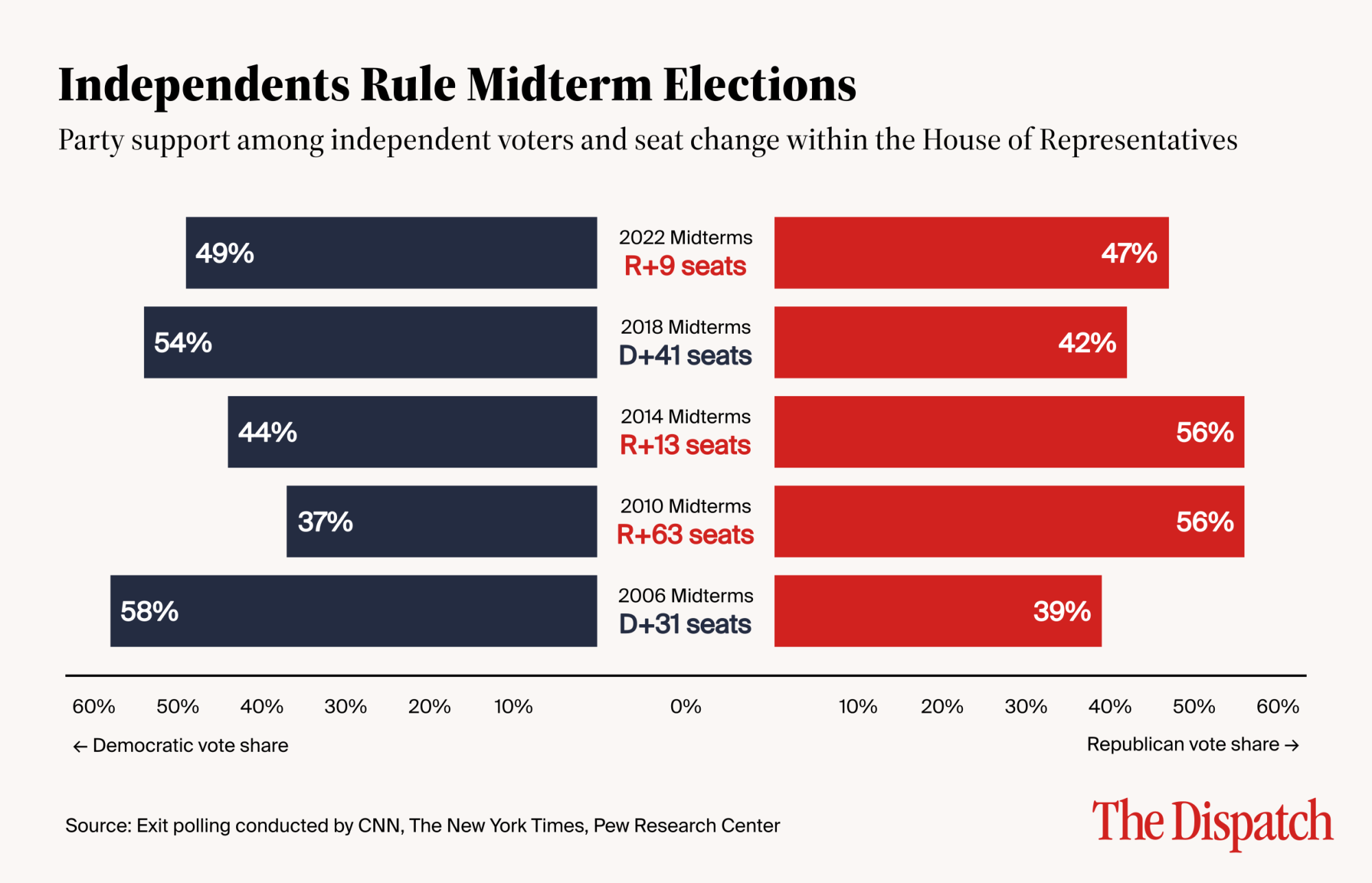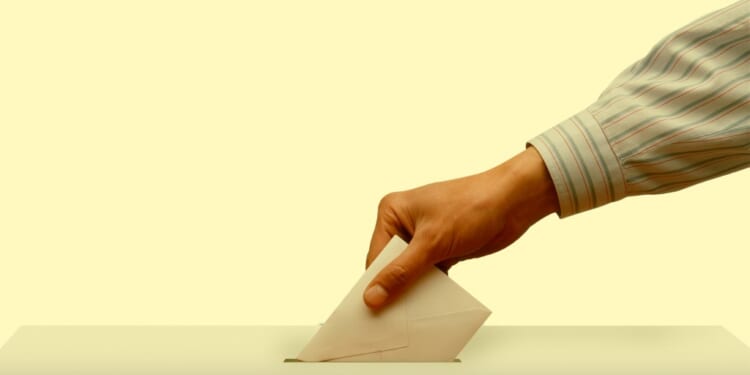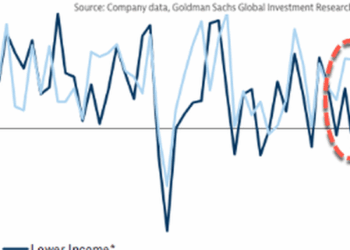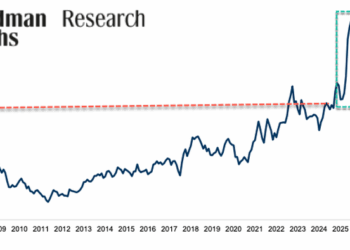Independent voters, decisive in midterm elections, have turned on President Donald Trump. But neither are they sold on the Democrats, complicating the minority party’s effort to win control of Congress in 2026.
Trump’s ratings with voters unaffiliated with the Democratic and Republican parties are in the tank, according to many public opinion polls stretching back several months—including surveys conducted after the mid-October Gaza ceasefire the president negotiated between Israel and Hamas. That’s good news for Democrats, who are virtually powerless in Washington, D.C. Since at least 2006, the party that romped with independent voters in midterm elections rode a wave of dissatisfaction with the president to control of the House of Representatives, the Senate, or both.
Except the Democrats also have problems with independent voters, per polls commissioned in the late summer and early fall.
Some surveys revealed the Democrats’ low ratings with independents were even lower than Trump’s low ratings. Others have shown unaffiliated voters are about equally displeased with the Democrats and Trump. If that continues deep into next year, 2026 could look a lot like the 2022 midterm elections. In that contest, the Democrats overcame President Joe Biden’s 42.2 percent job approval rating and avoided a red wave, increasing their Senate majority while nearly holding the House. How? By winning independents, 49 percent to 47 percent.
“Independents are just as unhappy with Democrats as they are with Republicans,” Republican pollster David Winston told The Dispatch. (This dynamic is among the reasons Republicans on Capitol Hill are not overly concerned about losing their majorities, at least not yet.)
Winston’s assessment is bolstered by a CBS News poll from early October that found Trump with a miserable 32 percent job approval rating among independents and Democrats with an even worse 25 percent favorable rating. A second national poll from the same time period, conducted by the GOP firm Deep Root Analytics and shared with The Dispatch, showed independents substantially happier with Trump and congressional Democrats. But the president, still underwater by 5 percentage points, edged the Democrats, who posted a net-negative rating of 7 points.
Meanwhile, a Republican pollster who regularly fields national surveys told The Dispatch after being granted anonymity that his polls usually show both Trump and the Democrats underwater by approximately 25 percentage points. “Independents dislike two things in American politics right now: Trump and the Democrats,” a second GOP pollster said. “Which one do they dislike more? That seems to ebb and flow [based on] the news of the week.”

Democrats are confident a turnaround is already underway.
They cite Trump’s vulnerability on the specific issue of affordability, voters’ No. 1 priority in most polls, and the economy generally, arguing the party is doing a better job of addressing voters’ concerns than the GOP. “We will win with independents this November [in New Jersey and Virginia] and in the 2026 midterms by making that contrast clear: leaders with real plans to lower costs vs Trump’s bailouts for billionaires at the expense of everyone else,” Mia Ehrenberg, Democratic National Committee spokeswoman, told The Dispatch in an emailed statement.
Independent voters matter because, historically, they dictate the outcome of midterm elections, which are often challenging for the party in the White House.
In 2006, Democrats won independents by 18 points, powering a blue wave that flipped 31 House seats and five Senate seats. Four years later, it was Republicans who dominated among independents, winning them by 19 points. That translated into a pickup of 63 House seats and six Senate seats. This pattern—of big gains among independents leading to big gains at the ballot box—repeated itself in midterm elections in 2014 and 2018. But in 2022, Republicans lost independents and missed several pickup opportunities.
Whether Democrats are on the cusp of improving their numbers with independents and laying a foundation for a blue wave next year could become clear soon. On November 4, voters will head to the polls for off-year elections in New Jersey, Virginia, and a few other states with closely watched races. But in the past week, some of the publicly available fresh polling is giving Democrats a reason to hope the data is headed in that direction.
In a YouGov poll for The Economist conducted October 17-20 (after the Gaza ceasefire was announced), just 27 percent of independents approved of Trump’s job performance, with 65 percent disapproving. The survey also showed Democrats leading the generic ballot among independents, with 32 percent of unaffiliated voters saying they would support a Democrat for Congress “if the election were held today” and only 19 percent saying they would back the Republican.
A second poll conducted post-Gaza ceasefire—from Emerson College—also showed Democrats leading the generic ballot among independent voters, 42 percent to 34 percent, although a whopping 24 percent were undecided. Meanwhile, a fresh Gallup poll gauging voters’ self-declared party identification offers an encouraging sign for the Democrats ahead of the 2026 midterm elections—and should be concerning for the GOP. According to the survey, more voters broadly identify as Democrats than Republicans, by a margin of 7 points.
That’s a significant advantage, and a 7-point gain for the Democrats since the beginning of the year, when it was tied. Why might this matter? Heading into last year’s presidential election, Gallup polling showed Republicans with a 4-point advantage, foreshadowing Trump’s reelection victory and the GOP pickup of four Senate seats to secure their first majority in the chamber since 2020.
CNN polling analyst Harry Enten noted during an appearance on the network that these party identification numbers are reminiscent of “what we had going into” 2018, Trump’s first midterm election cycle, when Democrats recaptured the House. “This is a metric that has been quite telling of elections,” he said.

















